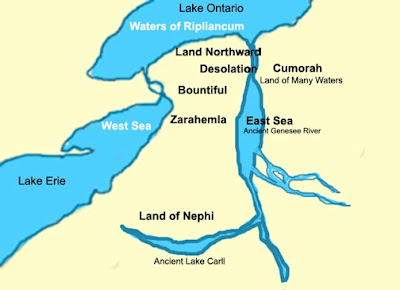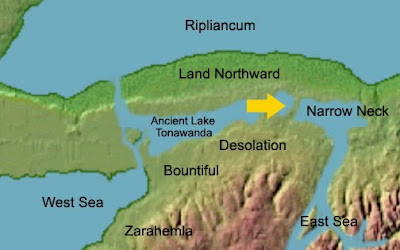Whether one quotes Alma 22:28-33, Omni 1:15-16, Helaman 6:10, or numerous other scriptures outlining geographical settings, the Great Lakes models simply fall far short of the written record.
One of the stances the Great Lakes theorists take is that North America, specifically the United States, is the only area of the Land of Promise in the Western Hemisphere. This despite numerous comments by Joseph Smith, Parley P. Pratt, and B.H. Roberts that the entire Western Hemisphere is the Land of Promise. Based in part of the misconception that Columbus discovered America—specifically the United States, a stance that flies in the face of actual history, we find that Christopher Columbus actually discovered islands in the Caribbean, and Central and South America.
Columbus never stepped foot on what we now know as the United States or what is considered continental North America. His first two voyages were only to the Bahamas, his third to the Bahamas and the Northern portion of South America, and his fourth to the Bahamas and Central America. When Nephi’s vision recorded in 1 Nephi 13:12 refers to Christopher Columbus, it would mean the land he discovered was part of the “promised land.”
In addition, when Jacob says “for the Lord has made the sea our path, and we are upon an isle of the sea,” one has to recognize that a) the Lehi Colony landed on an island in the sea, and b) where they landed and the “West Sea” would have been the same place. We also see that in Alma 22:28: ”and on the west in the land of Nephi, in the place of their fathers’ first inheritance, and thus bordering along by the seashore.” The place of their first landing “we did arrive at the promised land, and we went forth upon the land and did pitch our tents, and we did call it the promised land” (1 Nephi 18:23) was obviously their land of first inheritance, before Nephi was told to flee into the wilderness to escape his brothers (2 Nephi 5:5-6). Following this, Nephi records: “we did begin to till the earth, and we began to plant seeds” (2 Nephi 18:24), a very typical act of emigrants when first arriving in a new land.
This should preclude any thought that the Lehi Colony landed along the east coast of the United States and walked inland some 400 miles to Lake Erie (theorists’ west sea) and around to the west shore as Great Lakes Theorists claim.
Also, a description of the Land of Promise shows that the Land of Nephi (in the south), the Land of Zarahemla, and the Land of Bountiful (in the north) were in the Land Southward, south of the narrow neck of land, which Land Southward “was nearly surrounded by water” except for this “narrow neck of land between the Land Northward and the Land Southward” (Alma 22:32).
These theorists’ Land Northward is upon a tiny area, roughly situated between present day Rochester, New York, and the Niagara Falls, and southward from Lake Ontario to the ancient lake of Tonawanda (which was only four feet deep), an area about 25 miles by 65 miles in total—hardly large enough to encompass the vast distance of the Jaredite nation and the tens of millions of the Jaredite people. Also, whether there was a narrow neck between this ancient lake and the water source shown to the east of it on the map below is questionable. Geologists have nothing recorded by such a land bridge—at least none are shown in any drawings of the ancient lake bed.
Besides all this, there is no place in the Great Lakes where a large tract of land is completely surrounded by water except for a narrow neck.
 One example of the Great Lakes Land of Promise. The Land Southward is not nearly surrounded by water except for a narrow neck
One example of the Great Lakes Land of Promise. The Land Southward is not nearly surrounded by water except for a narrow neck One example of the Great Lakes Land of Promise. This narrow neck, between Lake Erie and Lake Ontario where Niagara Falls is located, is not nearly surrounded by water except for this narrow neck
One example of the Great Lakes Land of Promise. This narrow neck, between Lake Erie and Lake Ontario where Niagara Falls is located, is not nearly surrounded by water except for this narrow neck
 This Great Lakes Land of Promise has a narrow neck in a tiny area, leaving an extremely small Land Northward (see bottom map) and a narrow neck that does not provide a nearly surrounded Land Southward
This Great Lakes Land of Promise has a narrow neck in a tiny area, leaving an extremely small Land Northward (see bottom map) and a narrow neck that does not provide a nearly surrounded Land Southward




No comments:
Post a Comment